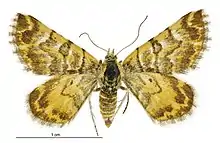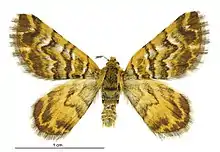Notoreas edwardsi
Notoreas edwardsi is a species of moth in the family Geometridae. It is endemic to New Zealand. This species has been classified as Nationally Critical by the Department of Conservation.
| Notoreas edwardsi | |
|---|---|
 | |
| Female | |
 | |
| Male | |
| Scientific classification | |
| Domain: | Eukaryota |
| Kingdom: | Animalia |
| Phylum: | Arthropoda |
| Class: | Insecta |
| Order: | Lepidoptera |
| Family: | Geometridae |
| Genus: | Notoreas |
| Species: | N. edwardsi |
| Binomial name | |
| Notoreas edwardsi | |
Taxonomy
This species was first described in 2010 by Brian Patrick and Robert J.B. Hoare.[3] It was named in honour of Eric Edwards.[3]
Description
N. edwardsi larvae start off life green in colour but quickly change to brown.[3] As they mature their colour changes again to pink purple with white lines running side to side on their body.[3]
Adult moths of this species have pallid orange and white transverse markings on their forewings with orange and black-marked hindwings.[3] N. edwardsi is similar in appearance to its close relations N. elegans and N. casanova.[3]
Distribution
This species is endemic to New Zealand.[2] It only occurs at Big Sandhill, Mission Bay on Stewart Island.[3]
Life cycle and behaviour
This species has only been seen in its natural habitat in December but it has been hypothesised that it may produce two broods in a season.[3] The female moth lays her eggs within the flowers buds of their hostplant.[4] When the larvae emerge from their eggs, they eat into the leaves or buds of their host, hiding from predators.[4] Once they are large enough, they emerge to feed from the fresh growth of the plant.[4] N. edwardsi pupate in a loose cocoon on the ground under their host.[4] The species spends approximately 43 days in their cocoon before emerging as an adult.[3] N. edwardsi are day flying moths.[4] They are low but fast flyers and constantly vibrate their wings to enable them to take off rapidly.[4]
Host species
The host plant for the larvae of N. edwardsi is the endemic plant Pimelea lyallii.[3]
Conservation status
This moth is classified under the New Zealand Threat Classification system as being Nationally Critical.[1]
References
- Hoare, R.J.B.; Dugdale, J.S.; Edwards, E.D.; Gibbs, G.W.; Patrick, B.H.; Hitchmough, R.A.; Rolfe, J.R. (2017). Conservation status of New Zealand butterflies and moths (Lepidoptera), 2015 (PDF). Wellington, New Zealand: New Zealand Department of Conservation. p. 6. ISBN 9781988514383.
- "Notoreas edwardsi Patrick & Hoare, 2010". www.nzor.org.nz. Landcare Research New Zealand Ltd. Retrieved 4 May 2018.
- Patrick, BH; Hoare, RJB; Rhode, BE (2010). "Taxonomy and conservation of allopatric moth populations: a revisionary study of the Notoreas perornata Walker complex (Lepidoptera: Geometridae: Larentiinae), with special reference to southern New Zealand". New Zealand Journal of Zoology. 37 (4): 257–283. doi:10.1080/03014223.2010.511127.
- Patrick, Brian (Autumn 2015). "Discovering New Zealand's gorgeous moths" (PDF). Butterflies and moths of New Zealand. New Zealand: Butterflies and moths of New Zealand Trust. p. 13. Retrieved 4 May 2018.
